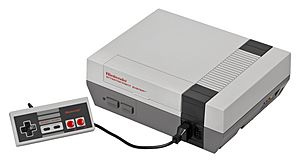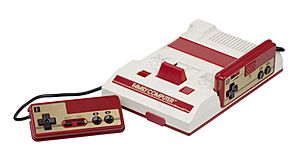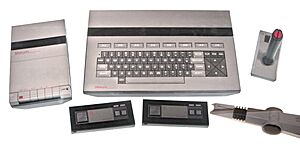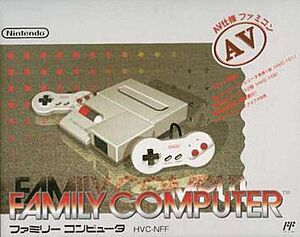History of the Nintendo Entertainment System facts for kids
The history of the Nintendo Entertainment System (NES) tells the story of how this famous video game console came to be. It started with the creation of the Family Computer (Famicom) in Japan in 1982. The Famicom was later changed and launched as the NES in North America in 1985. This console helped Nintendo become a huge global leader in video games during the late 1980s.
The Famicom and NES were 8-bit home video game consoles. They even competed with newer 16-bit consoles like the Sega Genesis. The NES was eventually replaced by the Super Nintendo Entertainment System (SNES) in 1991. However, Nintendo kept supporting and making the NES until 1995. Today, many people still love the NES, including collectors and those who use emulators to play old games. Nintendo even brought back classic NES games on its Virtual Console and with the NES Classic Edition.
Contents
How the NES Began: 1981–1984
Creating the Famicom in Japan
The video game world grew very fast in the late 1970s and early 1980s. Arcade games like Space Invaders were huge hits. Home consoles like the Atari 2600 also became popular. Nintendo, a company known for arcade games, wanted to join this growing market.
Nintendo wanted to create a home console that could play arcade games perfectly. They were inspired by games like Galaxian and their own hit arcade game, Donkey Kong. At the time, home systems weren't powerful enough to play Donkey Kong well. Nintendo's goal was to make a system that could.
In 1982, Nintendo's R&D2 team, led by Masayuki Uemura, started working on this new console. They wanted it to be cheaper than other systems but also more powerful. They looked at other consoles like the Atari 2600. Nintendo's president, Hiroshi Yamauchi, wanted a console that was better and cheaper than the Epoch Cassette Vision, which was popular in Japan.
Engineers decided to use an inexpensive 8-bit central processing unit (CPU). They also added a special graphics chip made by Ricoh. To save money, they decided not to include a keyboard or floppy disk drive. However, they added a special port for future add-ons like the Famicom Modem or Family Computer Disk System. They also used the D-pad from Nintendo's Game & Watch handhelds for the controller.
The Famicom Launches in Japan
Nintendo showed off the Famicom at an exhibition, and it was a big hit. It launched on July 15, 1983, in Japan. The Famicom was an 8-bit console that used game cartridges. It cost about $150 at the time. Its first games included Donkey Kong, Donkey Kong Junior, and Popeye.
The console was designed to look like a toy, with bright red and white colors. It had two gamepads attached to the sides. It sold very well at first, with 500,000 units sold in two months. However, some Famicom units had problems with their graphics chips. Nintendo recalled all faulty systems and fixed the issue, costing them millions of dollars.
After being reissued, the Famicom easily beat its competitor, the SG-1000. By the end of 1984, Nintendo had sold over 2.5 million Famicoms in Japan. This made it the best-selling console there. Nintendo also allowed other companies like Namco to make games for the Famicom, charging a 30% fee. This fee became a standard for video game publishing for many years.
Bringing the NES to the World: 1984–1987
Early Plans for North America
After its success in Japan, Nintendo wanted to bring the Famicom to other countries. They first talked with Atari about releasing the Famicom in North America. The plan was to call it the Nintendo Enhanced Video System. However, the deal fell apart. Atari saw a competitor showing a Donkey Kong game, and they thought Nintendo was also working with that company. Even though it was a misunderstanding, Atari's own money problems from the video game crash of 1983 stopped the deal.
The Nintendo VS. System in Arcades
After the video game crash of 1983, many American stores thought video games were just a passing trend. They stopped selling game consoles. But Nintendo believed there was still a market for games. So, they decided to introduce the Famicom to North America through arcades first.
In 1984, Nintendo released the Nintendo VS. System in arcades. This system used the same hardware as the Famicom. It was cheaper than other arcade systems but could play many different games. The VS. System was a huge success in North American arcades. By 1985, 50,000 units had been sold, making Nintendo a leader in arcades.
The success of the VS. System gave Nintendo the confidence to release the Famicom as a home console in North America. They called it the Nintendo Entertainment System (NES). This arcade success also helped Nintendo test new games and build a strong list of games for the NES launch.
The NES Gets a New Look
Nintendo wanted to avoid the bad reputation of video game consoles after the crash. So, they redesigned the Famicom for North America. They called it the "Nintendo Advanced Video System" (AVS) at first. It had a sleek, modern design with gray, black, and red colors. It looked less like a toy and more like a home computer.
Nintendo also added a special "lockout" system to the AVS. This system stopped unauthorized games from working, helping Nintendo control the quality of games. Games approved by Nintendo would carry the "Nintendo Seal of Quality."
The AVS was shown at a big electronics show in January 1985. It included a keyboard, a data recorder, and even wireless controllers. However, people at the show didn't like the keyboard or wireless features. The media was also doubtful that a new video game system could succeed in America.
The Nintendo Entertainment System is Born
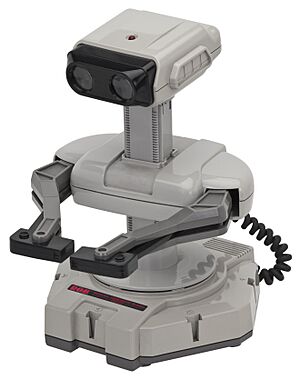
At another show in 1985, Nintendo returned with a simpler, cheaper version of the AVS. They dropped the home computer idea. To avoid calling it a "video game console," they renamed it the "Nintendo Entertainment System" (NES). They also called games "Game Paks" and the console a "Control Deck."
The NES kept the gray color scheme but had a new front-loading slot for game cartridges, like a VCR. This hid the game cartridge from view. It also had two ports for wired controllers instead of wireless ones.
To convince stores to sell the NES, Nintendo marketed it as an "entertainment system" or even a toy. They highlighted the Zapper light gun and, more importantly, R.O.B. (Robotic Operating Buddy). R.O.B. was a toy robot that reacted to flashes on the TV screen. R.O.B. helped attract retailers to Nintendo's booth, even though the robot itself wasn't very popular for playing games.
Launching the NES in North America
Since Nintendo couldn't find a big distributor, they decided to launch the NES themselves. A small team from Nintendo of America went to New York City for a test launch in October 1985. New York was chosen as the first market, which was a very bold move.
Nintendo made an amazing offer to retailers: they would handle all store setup and marketing. They also offered 90 days of credit and would take back any unsold systems. Retailers didn't have to pay anything upfront. This offer was very risky for Nintendo, but it convinced stores to sell the NES.
The first NES package was the Deluxe Set. It included the console, two gamepads, R.O.B., the Zapper light gun, and the games Gyromite and Duck Hunt. Fifteen other games, like Super Mario Bros., were sold separately.
Sales were encouraging during the 1985 holiday season. Nintendo sold almost 90,000 units in New York City. A survey found that many people bought the NES because their children wanted R.O.B. the robot. The NES was also praised for bringing arcade-style games into homes.
For the nationwide launch in 1986, Nintendo offered two packages: the $160 Deluxe Set and a cheaper $99 Control Deck package with the console, two gamepads, and Super Mario Bros.. Nintendo partnered with toy company Worlds of Wonder to help distribute the NES. By the end of 1986, Nintendo had sold 1.1 million consoles. They earned $310 million in sales, showing that video games were not dead after all.
NES in Europe and Other Regions
The NES also launched in Europe and Australia, but in a less organized way. It came to Scandinavia in 1986 and other parts of Europe in 1987 or 1988. In the United Kingdom, Ireland, Italy, Australia, and New Zealand, Mattel distributed the system.
In Europe, the NES wasn't as popular at first as it was elsewhere. The Sega Master System often sold more units in the UK. However, by 1994, NES sales had just barely overtaken the Master System in Western Europe.
In South Korea, the NES was sold as the Comboy by Hyundai Electronics starting in 1991. This was because of a ban on Japanese cultural products at the time. In Russia, an unofficial copy of the Famicom called the Dendy became very popular in the early 1990s, selling 6 million units.
NES Leads the Way: 1987–1990
By early 1987, the Famicom had sold over 9 million units in Japan, holding 95% of the home video game market. In North America, the NES sold 1.1 million units in 1986. By 1988, 12 million units had been sold in Japan, and it was expected to reach 10 million in the United States.
The NES easily outsold its main rivals, the Master System and the Atari 7800. Nintendo became the dominant company in the home video game market. Games like Super Mario Bros., The Legend of Zelda, and Metroid became huge hits. Super Mario Bros. was the best-selling video game for many years, selling over 40 million copies.
By 1990, over 27 million NES units were sold in the United States, found in 38% of American homes. This was more than any previous console, even beating the Atari 2600. Nintendo even became Japan's most successful company, surpassing Toyota. The NES's popularity greatly affected the computer-game industry, as many players switched to consoles.
The Final Years of the NES: 1990s
NES Slows Down and Stops Production
In the late 1980s, newer, more powerful consoles started to appear. NEC released the PC Engine (TurboGrafx-16 in North America) in 1987, and Sega launched its 16-bit Mega Drive (Genesis in North America) in 1988. These new systems started to take away Nintendo's market share.
Nintendo responded by releasing its own 16-bit console, the Super Famicom (SNES), in 1990. Even though Nintendo said it would keep supporting the NES, many players and game makers moved to the newer SNES. The last official NES games were released around 1994.
In 1993, a redesigned Famicom (model HVC-101) was released in Japan. It was smaller and looked like the SNES. It also had better video output. This model stayed in production for almost ten years, finally stopping in 2003. A similar redesigned NES (model NES-101) was released in North America.
After a decade of production, the NES was officially stopped on August 14, 1995. By then, over 60 million NES units had been sold worldwide.
Playing NES Games Today
Even after the NES was discontinued, millions of game cartridges still existed. People found them in secondhand stores and at yard sales. Many started collecting old NES games.
Around this time, computer programmers began creating emulators. These programs could make modern computers act like an NES. This allowed people to play NES games on their computers using ROM images (digital copies of game cartridges). Emulators also offered new features like saving your game anywhere.
Nintendo wasn't happy about ROM image trading, calling it software piracy. However, many people argued that emulation helped preserve classic games for future generations.
In 2005, Nintendo started offering classic NES games on its Virtual Console service for the Wii console. These games used Nintendo's own emulation technology. Popular titles like Mario Bros., The Legend of Zelda, and Super Mario Bros. were available.
In 2016, Nintendo released the NES Classic Edition. This was a small replica of the original NES that came with 30 built-in games. It was very popular and sold out quickly. Nintendo later re-released it in 2018.
See also


